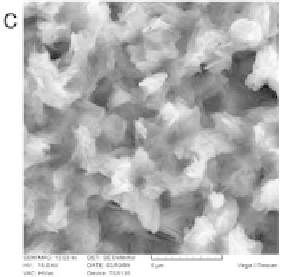Biomedical Engineering Reference
In-Depth Information
The anodic oxidation of the new class of the biomaterials:
Ti-45S5 nanocomposites, results in porous background attractive
for the Ca-P deposition [35]. The hydroxyapatite was cathodically
deposited by Jakubowicz
et al
. using two types of the electrolytes,
too [35]. The cathodic deposition results in surface coverage
by Ca-P compounds. Ca-P morphology after deposition from
HA-HCl electrolyte is shown on Fig. 9.77. Deposited Ca-P, using
second type of electrolyte, gave comparable results. The Ca-P
after deposition on non etched (lat) surface (Fig. 9.77a) results in
particles, which loosely adhere to the surface. The rough surface
results in Ca-P deposits that grown inside the pores and surface
after deposition is still rough (Fig. 9.77b, c). The deposited Ca-P is
build mainly from the small lamellas (Fig. 9.77c). Such prepared
rough surface with deposited HA should be very attractive for the
osseointegration process.
Figure 9.77
HA layer deposited on Ti-glass nanocomposite on lat (a) and
porous etched (b,c) sample (a, b: 3000 × magniication; c:
12000 × magniication) [35].


















